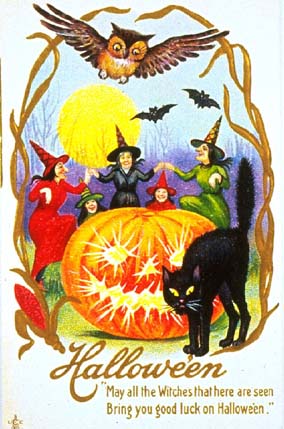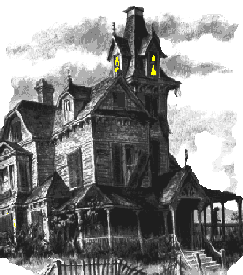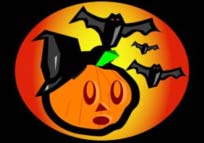|
Here are some Halloween History links. Scroll down for a only a small part of Halloween history
from the Wikipedia the free encyclopedia. If you wish to read more about it the Wikipedia's true entry on Halloween is much
larger.

Halloween is a holiday celebrated on the night of October 31, usually by children dressing in costumes and going door-to-door collecting candy. It is celebrated
in much of the Western world, though most commonly in the United States, Ireland, Scotland and Canada. Irish, Scots and other immigrants brought older versions of the tradition to North America in the 19th century.
The form "Halloween" derives from Hallowe'en, an old contraction, still retained in Scotland,
of "All Hallow's Eve," so called as it is the day before the Catholic All Saints holy day, which used to be called "All Hallows," derived from All Hallowed Souls. In Ireland,
the name was Hallow Eve and this name is still used by some older people. Halloween was formerly also sometimes called All
Saints' Eve. The holiday was a day of religious festivities in various northern European pagan traditions, until it was appropriated by Christian missionaries (along with Christmas and Easter, two other traditional northern European pagan holidays) and given a Christian reinterpretation.
Halloween is also known as the Day of the Dead, and it is a day of celebration for Wiccans and other modern pagan traditions, though the holiday has lost its religious connotations among the populace at large.

|
 |
|
Wikipedia (halloween)
Holidays.net
The Holiday Spot
Wilstar
Shining Rise
Neopagan
New Life
Halloween's theme is spooky or scary things particularly involving death, black magic, or mythical monsters. Commonly-associated Halloween characters include ghosts, witches, bats, black cats, goblins, zombies and demons, as well as certain fictional figures like Dracula and Frankenstein's monster. Homes are often decorated with these symbols around Halloween.
Black and orange are the traditional colors of Halloween. There are also elements of the autumn season, such as pumpkins and scarecrows, reflected in symbols of Halloween.
The jack-o'-lantern, a carved vegetable lit by a candle inside, is one of Halloween's most prominent symbols. In
Britain and Ireland, a turnip was and sometimes still is used, but emigrants to America quickly adopted the pumpkin because
it is much larger and easier to carve. Many families that celebrate Halloween will carve a pumpkin into a scary or comical
face and place it on the home's doorstep on Halloween night for fun. Traditionally, something like this was done in order
to scare evil spirits away.

|
 |
|
 |
|
|
|



